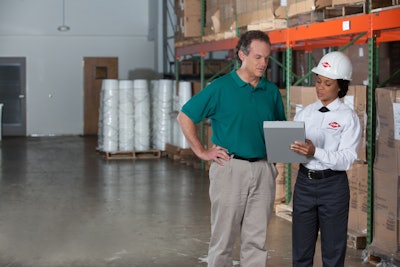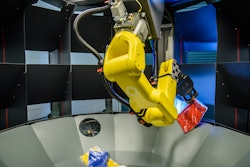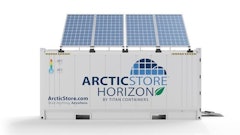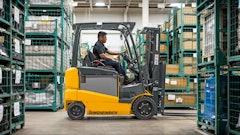
In 2018, there was a record number of food recalls, with over 380 products being pulled off the shelves. With recalls and outbreaks never seeming to cease, safety remains a major concern for consumers.
While it is companies’ intention to serve the consumer, they should also strive to protect them as well. It is crucial that companies put consumers first as food safety evolves in the warehouse.
Prevention Is Critical
Pest management is a major concern for warehouses, especially as companies start to build locations closer to city centers. Chelle Hartzer, technical services manager for Orkin, says that a majority of pest problems start outside. Determining entry points for pests and sealing them can be the first step to a mitigation plan.
“Looking for those entry ways and closing them is a great thing to do,” Hartzer says. “I make it all sound very simple, but I understand how that can be a challenge—especially with dock doors opening and closing all the time. That’s why we have screens for dock doors and screens that can seal any openings. You can also make the outside a little less hospitable. Cutting down trees a little and trimming bushes. Any place where pests can find resting spots and food sources on the outside. Cleaning up those spaces a little bit can push them out further.”
Sanitation also needs to be consistent throughout the warehouse. All living things need food, water and shelter. By making the environment in the warehouse less welcoming, it will make it harder for pests to get in and obtain those resources.
“This is a partnership. There are plenty of things that a pest control provider can do and there’s also plenty of things that a sanitation person can do on the facility side,” she says.
 Determining entry points for pests and sealing them can be the first step to a mitigation plan.Orkin
Determining entry points for pests and sealing them can be the first step to a mitigation plan.Orkin
Know Your Pests
The definition of a pest can vary, however. Hartzer explains it as something within the warehouse that is out of time and out of place. In a recent poll by the Supply Chain Network, 28.6 percent of respondents said that ants and rats were the most commonly seen pests in their facility. Cockroaches and flies followed behind at 14.3 percent as well.
“We don’t want insects in our food supply and we don’t want rodents in our warehouses, but there are things that we don’t consider to be pests. Look at birds, they are pretty and everyone likes them, but the minute that bird gets into your warehouse it is now considered a pest,” Hartzer says.
She adds that pest management can be as simple as using your eyes and looking out for pests, suggesting that employees be familiarized with pests that are common to the area so they know what to look for.
In addition, Hartzer advises that facilities use a pest mitigation log to track pest sightings. Those areas can then be quarantined to prevent further crossover into other areas of a facility. Meanwhile, it is important that everything gets inspected prior to being let into the logistics center.
“Your employees are there every day, they know what’s going on in your facility—use them to your advantage,” Hartzer advises. “We don’t want to just react when an incident happens, we want to be able to prevent it from happening altogether.”
Take a Proactive Approach
It’s all about being proactive, not reactive. Hartzer stresses that a pest management plan is essential as consumers demand to know how their food is sourced, processed and delivered. For example, having a monitoring system in place can help detect how a pest gets into the facility before it spreads.
“It’s challenging when you think of the food industry. We as humans need that food, but so do other things. So, it’s not always possible for complete prevention. What is possible is preventing the problem from getting any worse when it does happen. Make sure you inspect incoming goods for contamination so they can be refused,” she says.
The Food Safety Modernization Act (FSMA), first signed into law in 2011, helped improve warehouse safety, despite food recalls being on the rise.
The law gives the FDA the power to mandate a recall when companies refuse to do it voluntarily. The law also expands the agency’s ability to enforce preventative measures, such as having recall plans in place in case of an event.
However, on the pest management side, when FSMA was first enacted, very little changed because the food and beverage industry always had higher standards when it came to safety. Having a monitoring system in place can help detect how a pest gets into the facility before it spreads.Orkin
Having a monitoring system in place can help detect how a pest gets into the facility before it spreads.Orkin
“When FSMA came along from a pest management standpoint, not much really changed. The biggest change was documentation—we had to document a bit more when it came to our procedures. But we were already focusing on preventative strategies,” Hartzer says. “We already had integrated pest management approach. We were looking at exclusion and detailed inspections to find issues. So, for many of our actual practices, it didn’t change much.”
Still, pest management plans will always be changing. When considering how large some of the food facilities are and how much is going in and out of it each day, it is essential to have an updated plan in place. Hartzer recommends to review pest mitigation plans on a yearly basis as some requirements may have changed.
“It is absolutely essential to have an integrated pest mitigation plan in place,” Hartzer says. “This is a partnership. Even when you hire a third-party partner, there’s still a lot going on if your facility has to shut down for a few days, then you lose your customers. It is important to have plans in place to keep your supply chain running.”



















